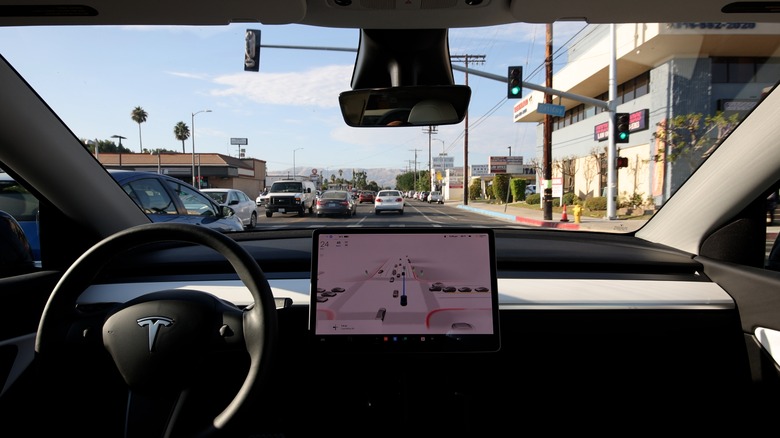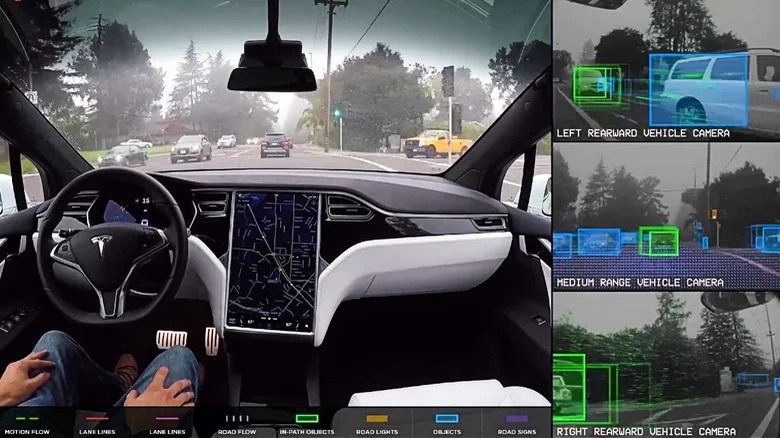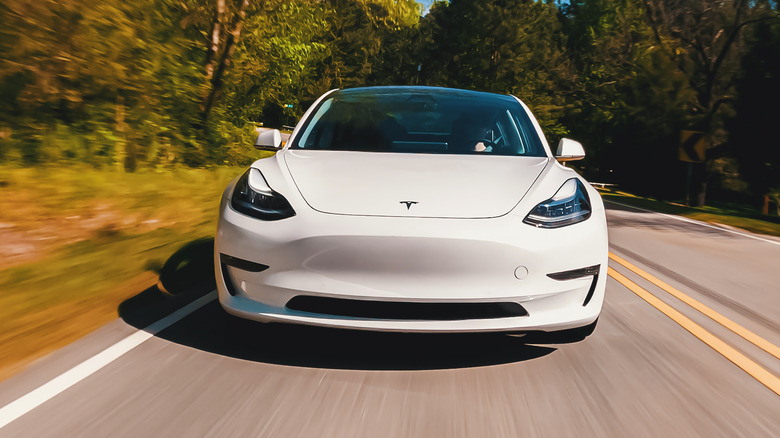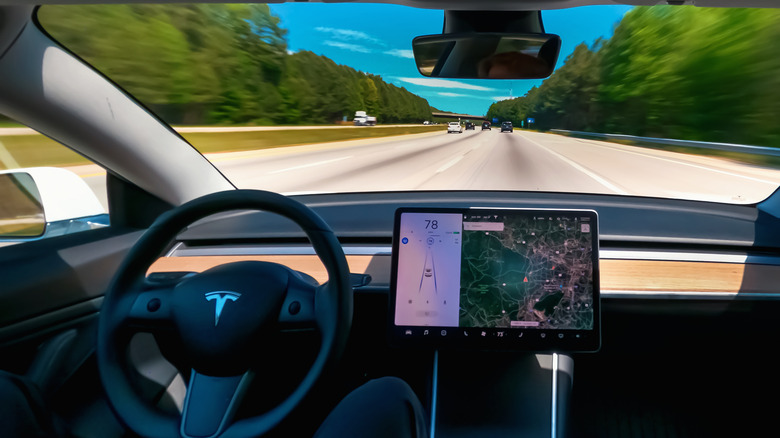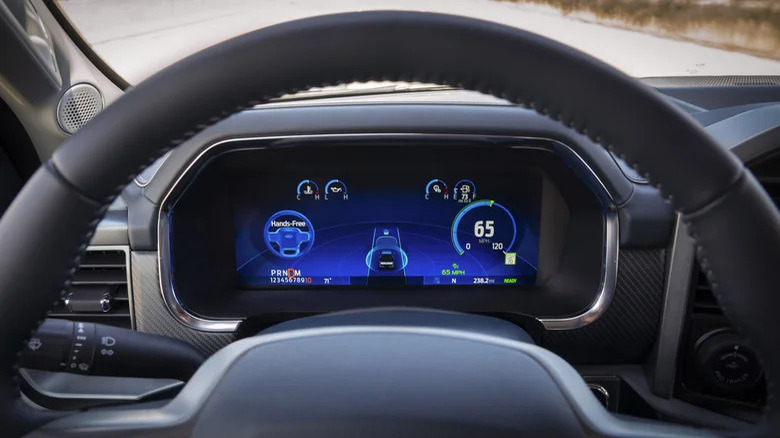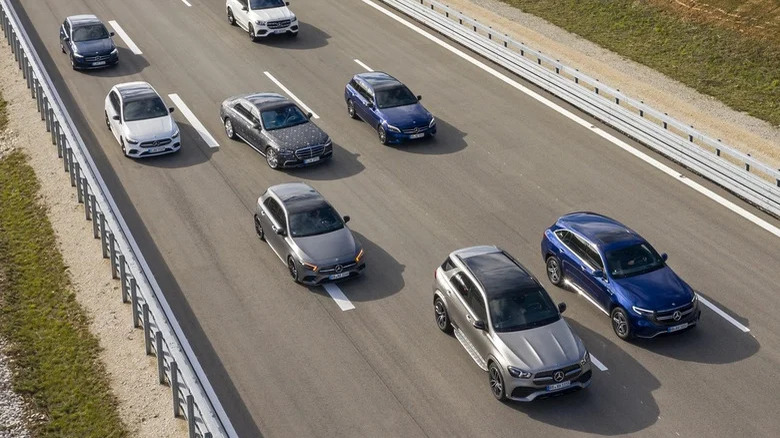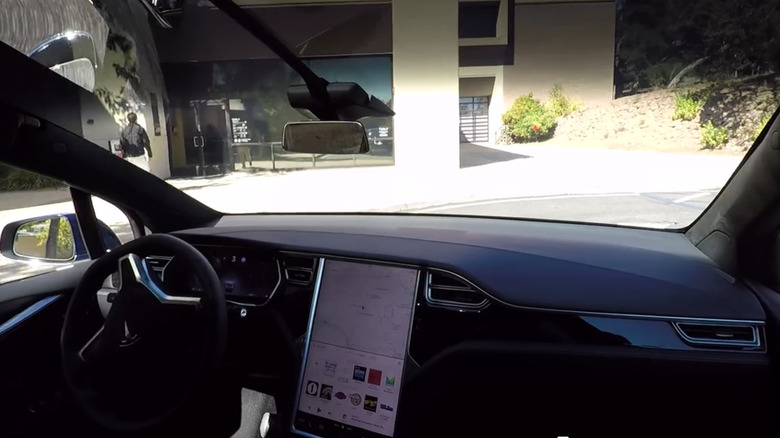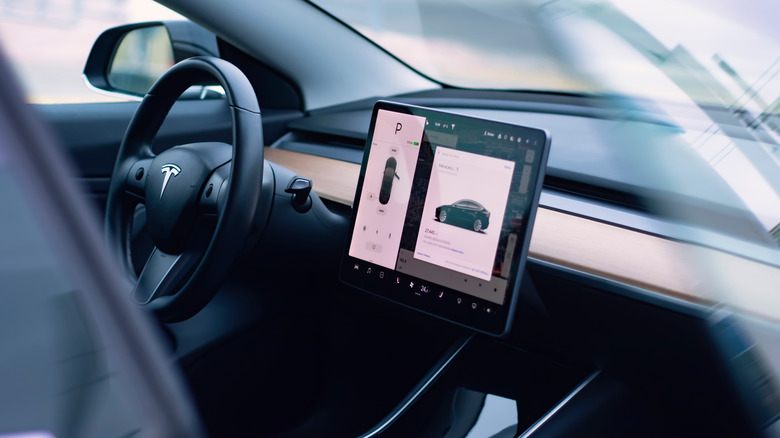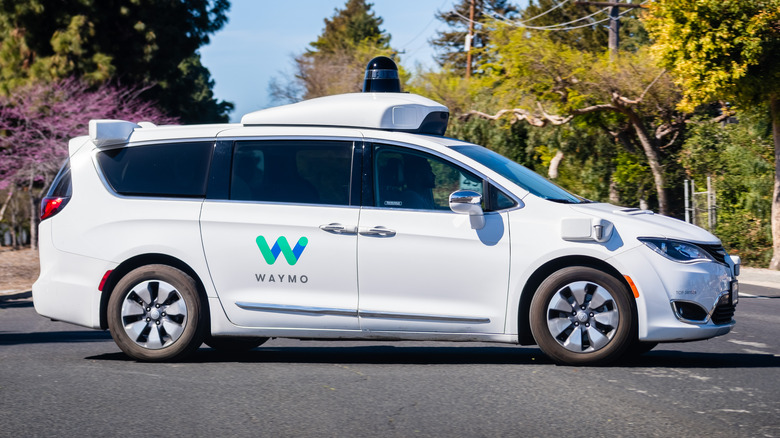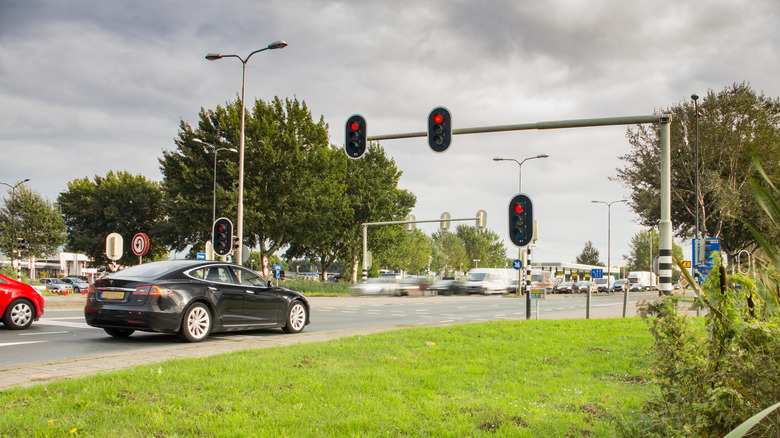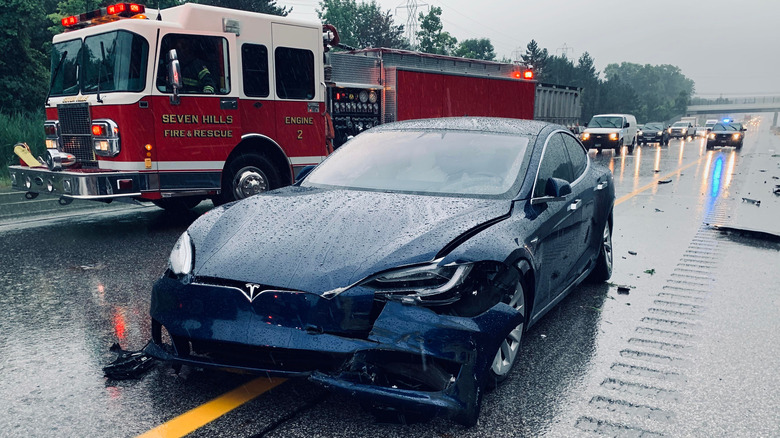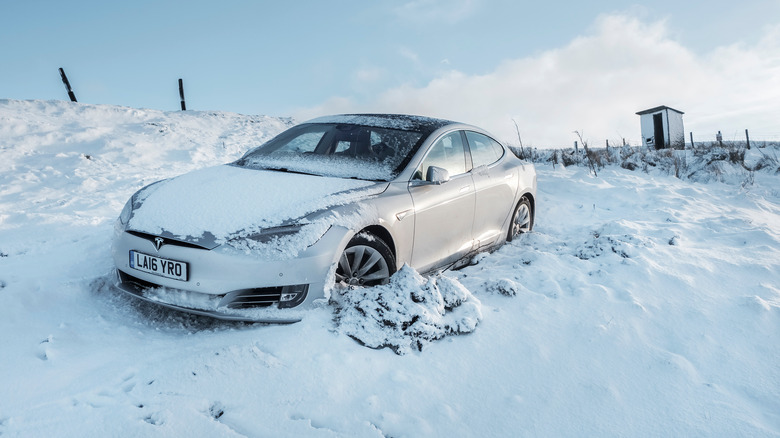The Biggest Myths About Tesla Self-Driving You Should Know About
Tesla is the top-selling electric vehicle manufacturer globally, with 17% of the worldwide market and 53% of the U.S. EV market. It managed this feat by aggressively pushing technology forward with battery tech, charging tech, motors, and AI. It now has four models in the range, S, 3, X, and Y, and is gearing up to release another three, the Cybertruck, Roadster, and Semi.
But Tesla didn't make electric vehicles just to look sexy on the outside; rather, it brought class-leading driving aids and other technology to the inside, too. Its active driving aids are the two most recognizable names in self-driving cars, Autopilot and Full Self-Driving. Both of these are designed to make the driver's time behind the wheel less stressful and safer by reading the road ahead, to the side, and behind, and predicting issues before they happen. The mythology around Tesla and its enigmatic CEO Elon Musk is almost as strong as the hype around its technology. We rounded up some misconceptions around its autonomous driving technology to do some myth-busting.
It's actually self-driving
Let's talk about the elephant in the room — Full Self-Driving (FSD) isn't a fully autonomous active driving assist in its current state. The name "Full Self-Driving" is more of an aspirational quote for what the system could be in the future. Tesla calls its advanced driving aid systems like Autopilot and FSD the "future of driving," which sounds good and could be accurate, but it's not the current situation. That's not to say it's not a good system. The Insurance Institute for Highway Safety (IIHS) released a study in 2017 that showed Autopilot in the Model S was responsible for an 11% drop in property liability claims and a 21% decrease in injury claims.
Tesla's Autopilot and FSD run on the same hardware and possibly the same software. The additional features that FSD gets are software-locked and can be purchased from the Tesla app on the owner's smartphone. The system uses eight cameras around the vehicle to analyze and respond to a 360-degree field of vision.
It is named appropriately
Autonomous self-driving vehicles don't currently have an "official" definition for which features are necessary for that name to be accurate. That's partly how Tesla can get away with calling its active driving aid "Full Self-Driving." Instead of a widely acknowledged definition, we have a classification for six levels of autonomous driving created by the Society of Automobile Engineers (SAE). This starts at Level 0, where the vehicle can monitor and advise, but the driver is in charge, to Level 5, where steering wheels are optional because the car can handle all of the driving functions. According to the SAE classifications, Tesla's Autopilot is a Level 2 support system where multiple active driver support features work in conjunction.
Level 3 is the next stage for Tesla to reach, and the only ADA system with this level of limited self-driving is Mercedes' Drive Pilot. This system can navigate through traffic, but only on pre-mapped sections of highway and at speeds lower than 40 mph. Level 4 and 5 of self-driving vehicles are each capable of driving the car on their own. Waymo and Cruise have Level 4 systems, although these are not commercially available or used outside small testing areas. Level 5 systems drive the car without human input, except perhaps to furnish a destination. This is what Tesla aspires to with Full Self-Driving, even if that destination is some years off.
It's synonymous with Autopilot
Autopilot is free with every new Tesla, as the base set of driver aids like emergency braking and cruise control, built into the base price of the vehicle. It contains the Autopilot systems and all necessary hardware to enable Full Self-Driving if the owner purchases the upgrade. Depending on the year the Tesla was purchased, it could have Autopilot or, before 2019, the purchasable Enhanced Autopilot system or FSD. All Tesla vehicles sold now come with the complete Autopilot package, including Automatic Emergency Braking, Front and Side Collision Warning, Obstacle Aware Acceleration, Blind Spot Monitoring, Lane Departure Avoidance, Emergency Lane Departure Avoidance, Traffic Aware Cruise Control, and Autosteer.
Full Self-Driving now costs $15,000 in the U.S. after the price was increased in September 2022. The beta driving aid system is Level 2, out of the five levels of autonomous driving. It consists of Navigate on Autopilot (Beta), Auto Lane Change, Autopark, Summon, Smart Summon, Traffic and Stop Sign Control (Beta), and Autosteer on city streets. It is now available for all Tesla owners in North America, after a long extended beta where drivers were picked from safety scores that Tesla calculated.
It's the class leader
With Active Driving Assistance systems (ADA), cars can change lanes on highways, brake, steer around obstacles, and accelerate without the driver intervening. Anti-lock brakes are one level of ADA, and so are reversing cameras, but the ones most people think of are those that take over some aspects of driving. Tesla has long touted its Autopilot and Full Self-Driving ADA systems, so much so that you'd be forgiven if you thought they were the class leader.
They're not, according to Consumer Reports, which tested the 12 most common ADA systems. Tesla came mid-pack, with seventh place. In CR's words, "that's because Tesla hasn't changed Autopilot's basic functionality much since it first came out." The other automakers have caught up and jumped ahead, with Ford's BlueCruise system taking the top spot. The safety experts at CR scored BlueCruise and GM's Super Cruise the highest as both use infrared cameras to monitor the driver for watchfulness. An alert sound is triggered if the driver stops paying attention to the road. If the driver continues to be distracted, the ADA system starts to slow the vehicle. Tesla's system allowed for hands-free driving for "about 30 seconds" before the driver was warned, which is nearly half a mile at highway speeds. That's too long, in CR's estimation, potentially leading to risky situations.
It's winning the race to Level 5
Tesla's ADA systems are both classified as Level 2 autonomous driving aids, according to the SAE. So are GM's Super Cruise, Ford's BlueCruise, Hyundai's HDA, and all commercially available active driving aids except for two – Mercedes' Drive Pilot and Honda's Sensing Elite. Honda only allows leasing of the Legend equipped with the Level 3 Sensing Elite system, on a limited production run of 100 cars, in its native Japan. Only one feature of the Honda system is Level 3, Traffic Jam Pilot, which can handle speed and steering in traffic jam conditions, leaving the driver free to operate the navigation system or even watch television. At all other times, the system works as a Level 2 vehicle, with hands-free adaptive cruise control, lane-keeping assistance, and low-speed follow.
Mercedes-Benz's system is the first to gain internationally valid regulatory approval after Germany's Road Traffic Act for Level 3 vehicles was enacted in 2017. The update to Drive Pilot means that the car can be in charge if multiple conditions are met. It has to be driving at 37 mph (60 kph), the minimum for cars driving on Germany's Autobahn. It also has to be on pre-mapped highways, and traffic density has to be high. The system also works only during daylight and not during inclement weather.
It's road-ready
Tesla has been selling Full Self-Driving since April 2019, when it was available for $5,000. The suite of active driving assistance features still isn't living up to the name, with an extended beta testing phase that only recently rolled out to more testers. That hasn't stopped Tesla from increasing its price to $6,000, then $7,000 in 2019, $8,000 and $10,000 in 2020, and $12,000 and $15,000 in 2022. That's a lot of money to be a beta tester.
The early adopters of FSD in 2019 couldn't use the system when they paid for it. Tesla didn't launch FSD Beta until October 2020 and only included a few thousand testers. Tesla gradually added more testers to the beta program until CEO Elon Musk tweeted that 160,000 were in the program in September 2022. At that time, Tesla hadn't released figures on how many owners had paid for FSD. It still hasn't, but the latest quarterly report says that the company had "released FSD Beta to nearly all customers in the US and Canada that bought FSD (approximately 400,000)." Nearly half a million customers bought FSD on a promise of future performance, without any assurance it would come to fruition.
It was working when first announced
The reporting team at Bloomberg discovered some shocking facts about the 2016 video announcing Full Self-Driving to the world. The advanced driving aid is one of the biggest draws for fans and investors. It costs $15,000, and enables Teslas vehicles to park themselves, valet to your position from parked, change lanes automatically, navigate to a set location, and make driving less stressful for the driver. It was also reportedly faked at launch, with hardcoded demo functions showcasing what the active driving aid could be.
According to Bloomberg, CEO Elon Musk was in charge of the demo video, even "dictating the opening text that claimed the company's car drove itself." Other emails seen by Bloomberg were sent to staff as late as 2 a.m., pushing staff to make the demo perfect. The emails suggest that parts of the demo drive were faked for the cameras, with the missive: "Just want to be absolutely clear that everyone's top priority is achieving an amazing Autopilot demo drive ... Since this is a demo, it is fine to hardcode some of it, since we will backfill with production code later in an OTA [over-the-air] update."
It's safer than you think
In 2021, Tesla removed the radar from all newly constructed Model 3 and Model Y vehicles sold in the U.S. This meant that Tesla Vision, the hardware and software that power the driving aids like Autopilot and Full Self-Driving offered by the company, changed to a camera-only system backed up by neural net processing. At that time, the Insurance Institute for Highway Safety (IIHS) and Consumer Reports removed Tesla's high marks for safety from the Model 3 and Model Y. The main reason was that the NHTSA removed checkmarks for multiple driving aid features that would not be available at the launch of the new Tesla Vision system. The missing features were forward collision warning, automatic emergency braking, lane departure warning, and dynamic brake support.
Tesla regained its safety ratings later that year. IIHS comprehensively tested the camera-only system in Tesla's Model 3 and found "the performance seems to be similar for both systems." The Model 3 again enjoyed its Top Safety Pick+ rating, and Consumer Reports returned its recommended status. The IIHS later retested the Model Y, and it also regained its Top Safety Pick+ rating, with the camera-only system meeting all requirements for the "plus" as long as they were produced after April 2021.
It doesn't require a human driver
Unlike competing autonomous driving systems like those from Cruise or Waymo, FSD still needs a human behind the wheel, with their hands on the wheel and their eyes on the road. For all its marketing moxie, Tesla acknowledges this in its support pages. That's a damper on the Robotaxi plan that CEO Elon Musk unveiled in 2019, enabling Tesla owners to rent their vehicles out to the Tesla Taxi troupe while not in use, like overnight while they slept. The vision said driverless Tesla Taxis would be operational in 2020, but they still haven't hit the roads three years later. The concept was reiterated in 2022's shareholder meeting, with Musk still claiming a self-driving "general solution" was on the way.
Competitor Waymo has self-driving cars that have been driving around with human safety drivers in some areas of the country. It recently showed off a prototype vehicle that doesn't have a seat for a human driver or even a steering wheel for one to use. Instead, the self-driving taxi has screens in front of each seat for the passenger's use. Another competitor, GM's Cruise, has been using self-driving taxis in San Francisco since the beginning of 2022. These taxis don't have a safety driver at all, and videos of users sitting in the back seat while the car drove them to their destination have been popping up on social media.
It complies with all road laws
For advanced driver aids like FSD to be road tested, you would think the system would need to be programmed with full knowledge of road laws and follow them. After all, that's the expectation put on human drivers when they get behind the wheel. In some cases, Tesla introduced features that contravened traffic law in some states by allowing a traffic violation and posing a safety risk. The NHTSA issued a safety recall in January 2022 to remove this feature from the firmware of some 53,822 vehicles in the U.S.
In October 2020, the small pool of FSD beta testers got a firmware update that added the "Rolling Stop" feature. The feature could allow the Tesla to creep through a four-way stop, provided there were no cars, pedestrians, or bicyclists in view, at a speed of no more than 5.6 mph. The feature had to be manually enabled in the settings, and the intersection had to have a maximum speed limit of 30 mph on the roads leading up to it. While Tesla said it was not aware of any crashes from the feature, it decided to not fight the NHTSA and removed it with a subsequent firmware update.
It never makes mistakes
The driving aid in Tesla vehicles is fully based on camera input, without any backup system like LiDAR or radar to double-check when it can't identify an object correctly. This can lead to the system being confused by ordinary, everyday things like the moon, which can appear like a yellow traffic signal under some atmospheric conditions. The Tesla, in this situation, kept trying to slow down whenever it could see the moon, with a minor slowdown that could have caused issues if another driver had followed closely.
Another glitch made the rounds on social media in April 2021. A Twitter user and Tesla owner, Andy Weedman, noticed that his car "kept slamming on the brakes" in a road section with no traffic signs. After a few drives on the suspect section of the street, he noticed that a billboard off to the right side had a giant stop sign on it. He went back and did a longer recording of the issue, which shows his Tesla decelerating from 35 mph to a full stop once it got close enough to the billboard. That could have real implications for any driver following a Tesla on that section of road, or any area with billboards or other graphics that the driving aid thinks are real road signs.
It always detects emergency vehicles
In August 2021, the National Highway Traffic Safety Administration (NHTSA) opened an investigation into Tesla after many accidents involving first responders or emergency vehicles that were active at the scene of existing incidents. At the time, 11 crashes of Tesla vehicles into active first responder scenes had been identified, involving 17 injuries and one fatality. All crashes were confirmed to be using Autopilot or Traffic Aware Cruise Control at the time of the accident.
The NHTSA said that most crashes happened after dark, and the first responders had laid out flares, illuminated arrow boards or cones, and used their flashing lights. The entire lineup of Tesla vehicles was subject to the investigation, Models Y, X, S, and 3, starting with the 2014 model year and continuing to the 2021 models. The first of the crashes involving emergency vehicles tracks back to January 22, 2018, when a Tesla using Autopilot plowed into a firetruck in Culver City, California. The other ten crashes before the investigation started were scattered across the country, from Florida, Michigan, Texas, North Carolina, Arizona, Massachusetts, Indiana, and Connecticut, and one more in California.
It has never been involved in a fatal accident
Driving aids are a net positive, making the roads safer and generally stopping serious accidents before they happen. Sometimes that's not the case, however, and several Tesla-involved crashes have resulted in fatalities. The NHTSA issued a standing general order in 2021 for every carmaker to report crashes involving advanced driver assistance systems, like that in Tesla's Full Self-Driving. Since the General Order went into effect, 811 crashes have been reported, with 633 of those reported by Tesla. In that time, 18 fatalities were reported while advanced driving assists were used.
In the last two years, multiple crashes involving Tesla and Full Self-Driving have resulted in fatalities. In April 2021, a 2019 Tesla Model S left the roadway north of Houston, TX, and burst into flames. The blaze took four hours to put out as lithium-ion batteries are difficult to extinguish. This crash was notable for another reason — the vehicle seemed to have nobody in the driver's seat at the time. The first autopilot-related crash was disclosed by Tesla in 2016 when a Model S in autopilot mode "failed to distinguish a large white 18-wheel truck and trailer" from the bright spring sky and drove full speed under the trailer.
